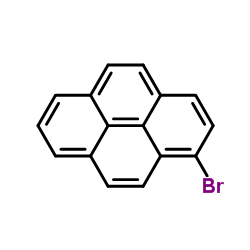1-Bromopyrene

1-Bromopyrene structure
|
Common Name | 1-Bromopyrene | ||
|---|---|---|---|---|
| CAS Number | 1714-29-0 | Molecular Weight | 281.147 | |
| Density | 1.6±0.1 g/cm3 | Boiling Point | 422.5±14.0 °C at 760 mmHg | |
| Molecular Formula | C16H9Br | Melting Point | 102-105 °C(lit.) | |
| MSDS | Chinese USA | Flash Point | 209.4±14.5 °C | |
| Symbol |

GHS07 |
Signal Word | Warning | |
|
Cumulative health risk assessment of halogenated and parent polycyclic aromatic hydrocarbons associated with particulate matters in urban air.
Ecotoxicol. Environ. Saf. 113 , 31-7, (2015) Halogenated polycyclic aromatic hydrocarbons (HPAHs) have been reported to occur widely in urban air. Nevertheless, knowledge about the human health risk associated with inhalation exposure to HPAHs is scarce so far. In the present study, nine HPAHs and 16 PA... |
|
|
Confocal and fluorescence lifetime imaging sheds light on the fate of a pyrene-tagged carbon monoxide-releasing Fischer carbene chromium complex.
Dalton Trans. 44(11) , 4957-62, (2015) The synthesis of a new pyrene-containing Fischer carbene complex is described. The complex has a broad absorbance spectrum between 300 and 400 nm and, on excitation at 345 nm in CH2Cl2 solution, emission is observed at 395 and 415 nm. Emission is also observe... |
|
|
Synthesis and characterization of oligodeoxynucleotides containing the major DNA adducts formed by 1,6- and 1,8-dinitropyrene.
Org. Lett. 2(13) , 1871-4, (2000) [reaction: see text] An efficient method for the synthesis of oligonucleotides containing a site-specific DNA adduct formed by the carcinogens 1,6- and 1, 8-dinitropyrene has been developed. Palladium-catalyzed amination provided a straightforward route for t... |
|
|
Photophysical properties of symmetrically substituted diarylacetylenes and diarylbuta-1,3-diynes.
Photochem. Photobiol. Sci. 15 , 45-56, (2016) A series of symmetrically substituted diarylacetylenes and diaryl-1,3-butadiynes were prepared and studied with an emphasis on their spectral and photophysical properties. The photophysical characteristics of these compounds were studied in relation to their ... |
|
|
Structure-dependent lipid peroxidation by photoirradiation of pyrene and its mono-substituted derivatives.
J. Environ. Sci. Health. A. Tox. Hazard. Subst. Environ. Eng. 48(3) , 233-41, (2013) Pyrene, one of the most studied polycyclic aromatic hydrocarbons, can damage biological macromolecules and cause toxicity when irradiated by light. The effect of substituents, 1-amino, 1-hydroxy, 1-nitro, and 1-bromo, on light-induced lipid peroxidation is st... |
|
|
Regioselective and stereoselective metabolisms of pyrene and 1-bromopyrene by rat liver microsomes and effects of enzyme inducers.
Drug Metab. Dispos. 16(2) , 173-83, (1988) Due to the symmetrical property of pyrene (Py), trans-dihydrodiols formed at 4,5- and 9,10-positions are identical, as are the monohydroxylated products (phenols) formed at C1, C3, C6, and C8 positions. With a bromo substituent at C1 position of Py, 1-bromopy... |
|
|
Electronic polarization reversal and excited state intramolecular charge transfer in donor/acceptor ethynylpyrenes.
J. Phys. Chem. B 109(35) , 16628-16635, (2005) An attempt to tune the electronic properties of pyrene (Py) by coupling it with a strong electron donor (-PhNMe2, DMA)/acceptor (anthronitrile, AN) through an ethynyl bridge has been undertaken. A moderate electron donor (iPrOPh-, IPP)/acceptor (2-quinolinyl,... |
|
|
DNA damage and repair of human skin keratinocytes concurrently exposed to pyrene derivatives and UVA light.
Toxicol. Res. (Camb.) 2(3) , 193-199, (2013) Polycyclic aromatic hydrocarbons (PAHs), a class of mutagenic environmental contaminants, insert toxicity through both metabolic activation and light irradiation. Pyrene, one of the most widely studied PAHs, along with its mono-substituted derivatives, 1-amin... |
|
|
Gas-phase UV spectroscopy of anthracene, xanthone, pyrene, 1-bromopyrene and 1, 2, 4-trichlorobenzene at elevated temperatures. Thony A and Rossi MJ.
J. Photochem. Photobiol. A: Chem. 104(1) , 25-33, (1997)
|
|
|
Electron affinities of polycyclic aromatic hydrocarbons determined by the kinetic method. Chen G and Cooks RG.
J. Mass Spectrom. 30(8) , 1167-1173, (1995)
|